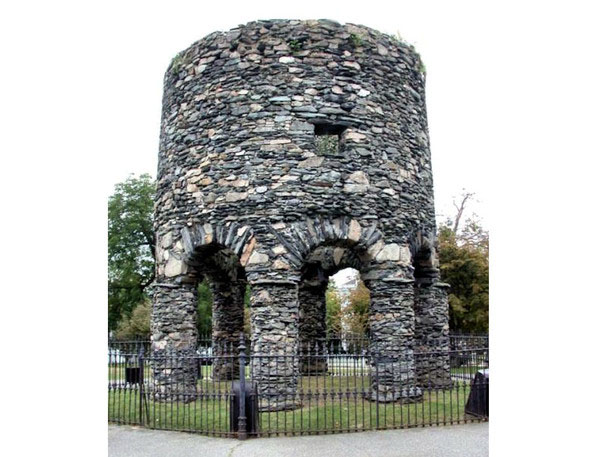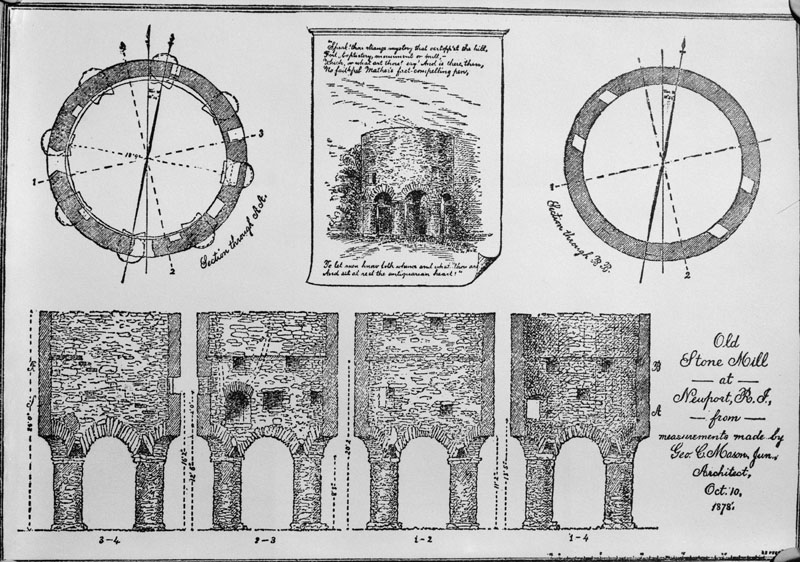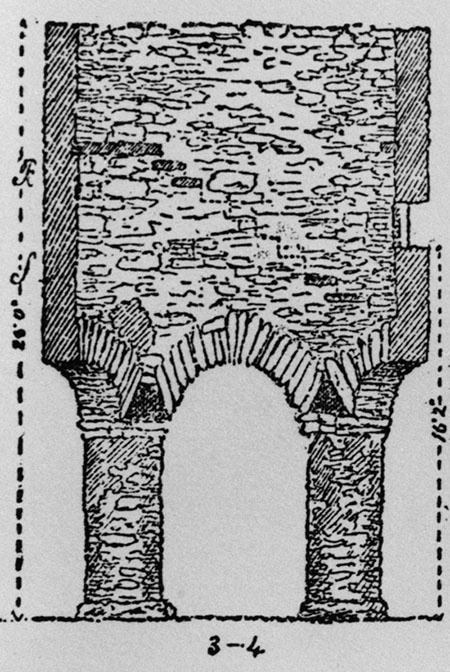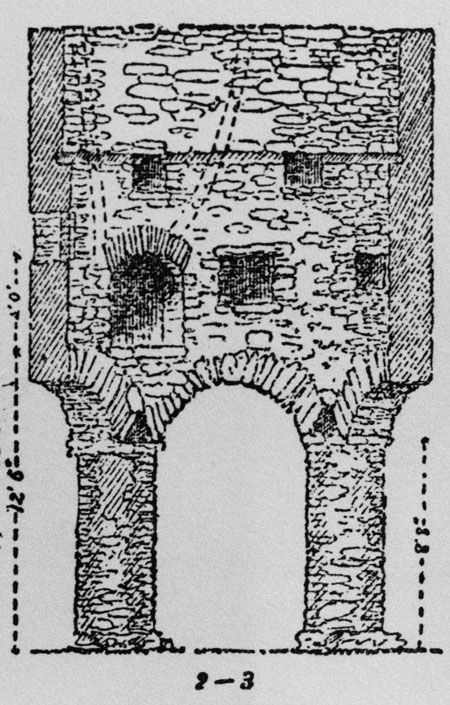
THE DESIGN ASPECTS OF THE NEWPORT TOWER.
Having established, quite convincingly, that the Newport Tower is tied to local hills and solstice positions, in a deliberate surveying sense, by way of very recognisable, coded distances and angles, including a due North orientation onto Miantonomi Hill, we can begin to analyse the code-bearing design attributes of the tower itself.

If the Newport Tower was built in pre-Columbian times, then it undoubtedly acted as a mnemonic structure and repository of length, breadth, height, circumference and angle codes, consistent with thousands of geometric earth-embankment and mound-group complexes scattered across ancient North America.
So, why was there a need for thousands of code-bearing structures in North America, built from the dawn of the Bronze Age (circa 3000 BC and thereafter)?
Most Americans and others don't know that these "coded structures" even exist, let alone that they were set out according to well-known, ancient Mediterranean, Continental European and British Isles measurement and angle standards. Examples of such structures are, the Octagon geometric earth-mound complex of Newark, Ohio or the Cahokia mound group of Collinsville, Illinois, etc., etc.
The reason for building them was to preserve the scientific principles of astronomy and, especially, how astronomy related to navigation. The complexes were "open air universities" for teaching young student navigators the refined navigational arts on land, long before they were entrusted with a ship on the vast, featureless oceans.
From the Bronze Age, North America was the centre of huge transient traffic of ships transporting raw copper from the Great Lakes region, across the North Atlantic to the British Isles and further afield into the Mediterranean. Copper, mixed with about 10% tin and other alloys made bronze ... the most sought after commodity of that time and, often, more precious than gold. The European-Mediterranean Bronze Age was fuelled by North American copper.
To see how one of these ancient North American "open air universities" worked, see: http://www.celticnz.co.nz/Cahokia/Cahokia1.htm
To see how a similar ancient Orkney Island, Scotland "open air university" worked, see: http://www.celticnz.co.nz/Brodgar/Brodgar%201.htm

Archaeologists and other researchers have complained about the difficulty in getting precise measurements of the Newport Tower, because of its very rough internal and external surfaces or slightly elliptical circumference. However, a concerted effort to measure the structure was undertaken by architect, George C. Mason in 1878 and he provides a very close approximation of its measurable ground to height features, scaled positions of windows & internal recesses, as well as their size and shape, etc.
Some have claimed that George C. Mason's measurements were not 100% accurate over the fullness of the tower (like omitting to indicate that the tower is slightly elliptical rather than perfectly round). However, his height measurements would have been relatively easy for a professional architect to make with accuracy and these can be analysed to see if they comply to common, coded measurements of antiquity that were no longer in known usage by the dawn of the American colonial period.
One hopes however, that the "ground level" George C. Mason chose to measure from truly did represent the "ground-zero level" that the original builders worked from, and not an unrelated, spurious and meaningless level atop centuries of humus build-up. As a seasoned architect, he should have taken this into account before undertaking his survey and providing height measurements.
In the following preliminary analysis, we'll just work from and consider the measurements he supplied. This exercise should, at least, demonstrate how a "coded structure" would work and, pending a far more accurate survey, or verification of Mason's measurements of 1878, what the intended, in-built codes might have been.
ARE VERY "OLD-WORLD" CODES BUILT INTO THE DIMENSIONS OF THE NEWPORT TOWER?

George C. Mason measured the overall height of the tower to be 28', with drawn variations. He also noted that the ground to window sill height for this quarter segment was 16' 2", which translates to 194".
If the tower were pre-colonial in origin and built as a mnemonic structure for teaching initiates the ancient methods of navigation and cyclic astronomy, then this ground to sill height value would have been read as 194.4", for the following reasons:
With the ancient method of describing the equatorial circumference of the Earth as 12 X 12 X 12 X 12 X 1.2-miles = 24883.2-miles, the sum of 194.4-miles would be 1/128th part. This is consistent with the normal method of dividing up the compass into 1/2, 1/4, 1/8, 1/16, 1/32, 1/64 & 1/128 parts, etc.
The value 194.4 or 1944, etc., occurs constantly in ancient metrology. For example:
Under the ancient Greek capacity system for liquid volumes was the Chous……194.40 cubic inches.
This height value on the Newport Tower would also equate to 16 & 3/5ths Roman feet (11.664" for a lunar foot and 11.66666" for an overland foot).
All of the ancient Weights, Measures & Volume standards of a confederation of cousin civilisations and trading nations in the BC era had to contain scientific or measurement information in each volume-capacity or grain-weight, etc. All such standards related to such things as the equatorial circumference of the Earth or the lunar cycle, etc.
Similarly, the slightly meandering height of the tower would have been dual read as both 28' (calendar and navigational progression) and 28.35' (lunar progression) for the following reasons:
The sum of 28', of course, accentuates the value 28, which was used to describe the duration, in days, for a solar month under the ancient Sabbatical Calendar system, with 13 such months in a solar year (set at 364-days under this system). The Calendar was allowed to run undisturbed for 7-years before 9 intercalary days were inserted, during the Sabbatical Year festival, to fully correct the calendar.
The sum of 28' equates to 336". The ancient Irish mile was 6720' (3360' X 2) and there would be 19440 Irish miles in the 24883.2 Greek mile (of 5250' each) equatorial circumference. This is the literal navigational system built into the base dimensions of the Great Pyramid of Egypt (756' per side or 3024' for one complete perimeter circumnavigation).
On the Great Pyramid, two perimeter circumnavigations was 6048' (336' X 18) for 1-minute of equatorial arc. In other words, 336' X 18 X 60 = 1-degree of arc ... X 360 = the full equatorial circumference of the world.
Put another way: This means there were 54 Irish miles (of 6720' each) in 1-degree of equatorial arc under the literal geodetic system built into the Great Pyramid's base perimeter length and that the sum of 1-minute of arc was 9/10ths of an Irish mile.
Note also: The ancient Alexandrian weight for a Mina was 672 grains.
Similarly:
The duration of lunar year is 354.375-days (354 & 3/8ths) and 8 lunar years = 2835-days.
The Khafre Pyramid of Egypt (built as a pyramid of the moon) is 708.75' per side (354.375' X 2), for a full perimeter measurement of 2835'.
A mathematical progression, based upon 28.35 or larger, whole-number, expressions will generate many of the essential numbers for reading the cycles of the Moon, including the longest enduring cycle where the Moon goes to Lunar Major Standstill (each 6804-days ... 283.5-days X 24 or 19.2 lunar years).

Mason gives a measurement of 12' 6" (150 ") from the ground to the centre of a door arch and a measurement of 16' 6" (198") to the sill of yet another window. He also shows the height to the top of a support column to be 8' 8" or 104".
In terms of feet, 150' would be 1/35th of a Greek mile of 5250'.
Another very important, close proximity, coded measurement useful in tutorials would have been 151.2" (two side lengths of the Great Pyramid were 1512' for 1/4th of 1-minute of equatorial arc).
But there was, as mentioned, a second navigational system built into the base dimensions of the Great Pyramid. By elongating one side a mere 3", one minute of arc became 6050' instead of 6048' and this alternative reading used (what became known as) the English mile of 5280' instead of the Greek mile of 5250'. Whereas the English mile was based upon progressions within the "11" number family, the Greek mile was based upon progressions of the "6&7" number families combined.
Under the 5280' mile navigational system, the equatorial circumference of the Earth was considered to be 24750-miles or 150 X 165. It's worthy to note that the ancient rod measurement was 16.5' and the ancient English league was 16500' (3.125-miles).
The extended measurement Mason gives to the window sill produces 198".
In terms of English miles, the sum of 198-miles would be 1/40th of the diameter of the Earth (7920-miles) under the ancient reading that was based upon factorable numbers. It would also be 1/125th of the 24750-mile equatorial circumference.
Alternatively, the sum of 198' would equate to 1/30th of an ancient Scottish mile of 5940' (1920 ells of 37.125" each). The Scottish mile was 1-furlong (660' or 10 chains) longer than the English mile.
Likewise, the sum of 198' (3 chains of 66' each) would be 1/660000th of the equatorial circumference under the 24750-mile reading.
Mason's measurement of 104" (rounded) to the top of a column was, undoubtedly, meant to convey or encode a very special number from the ancient parcel of scientific numbers shared by many cousin civilisations.
This was 103.68" (103 & 17/25ths).
The ancient Jerusalem Liquid Cab volume was 103.68 cubic inches. This is exactly the same as the old Scottish, Stirling Jug volume.
The length of 103.68" equates to 5 of the longest of the Egyptian Royal cubits identified by William Flinders Petrie @ 20.736" each, wherein he measured the coffer in the King's chamber of the Great Pyramid to be 103.68" (or 1.728'). This height reading at the Newport Tower is, therefore, 5 Egyptian Royal cubits or the length of the coffer.
Note: 20.736-miles = 1/1200th of the 24883.2-mile circumference.
The 103.68 value, or larger renditions of the same, is one of the truly important numbers from the ancient parcel of scientific values, for the following reasons:
With the Earth configured to be 12 X 12 X 12 X 12 X 1.2-miles in circumference, how fast is it spinning in miles per hour?
Therefore, 24883.2 ÷ 24-hours = 1036.8 MPH.
So, this coded value also tells us that 1036.8-miles is 1/24th of the Earth's equatorial circumference, a very important piece of scientific information to encode into a mnemonic structure for ongoing tutorials to generations of initiates.